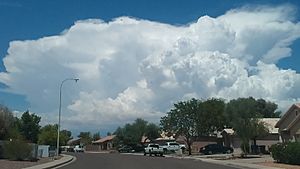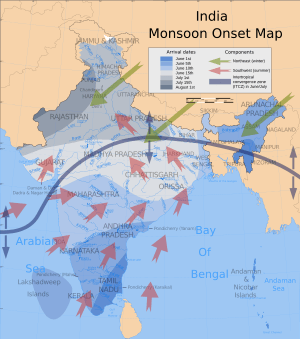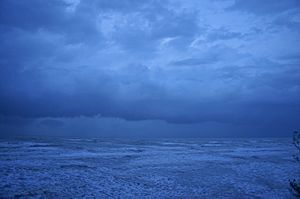Monsoon facts for kids
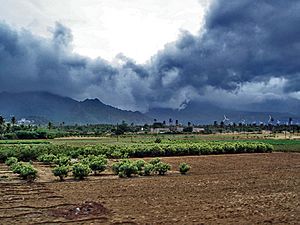
A monsoon is a special type of seasonal wind that blows for several months. It brings a lot of rain to certain parts of the world. The word "monsoon" was first used in English to describe the seasonal rains in India. These rains come from the Indian Ocean and Arabian Sea in the southwest, bringing heavy rainfall to the land.
Monsoons happen in many other places too. You can find them in North America, Sub-Saharan Africa, Brazil, and East Asia.
Contents
How Monsoons Work
The way monsoons work is quite simple. Land heats up much faster than water. For example, in India, land temperatures can be over 45°C, while the nearby ocean stays around 20°C. This big difference in temperature is key.
When the land gets very hot, the air above it also heats up and rises. This creates an area of low pressure over the land. Cooler, moist air from the ocean then rushes in to fill this space. As this ocean air moves inland, it carries a lot of moisture. When this moist air rises, it cools down and forms clouds, releasing its moisture as rain. This is what we call the summer monsoon.
Mountains, like the Tibetan Plateau, can also help. They force the moist ocean air to rise even higher, causing more rainfall.
Monsoons Around the World
African Monsoons
The monsoon in western Sub-Saharan Africa happens because of how the Intertropical Convergence Zone (ITCZ) moves. The ITCZ is like an imaginary line around the Earth where winds from the north and south meet. There are also big differences in temperature and humidity between the Sahara desert and the Atlantic Ocean.
This monsoon moves north from the Atlantic Ocean in February. It reaches western Africa around June, bringing rain. Then it moves back south by October. Dry, strong winds from the northeast, called the harmattan, are stopped by this shift. Instead, southerly winds carrying rain take over during the summer. Places like the Sahel and Sudan rely on this rain for most of their water.
North American Monsoon
The North American monsoon (NAM) happens from late June or early July until September. It starts in Mexico and spreads into the southwest United States by mid-July. It affects areas like Arizona, New Mexico, Nevada, Utah, Colorado, West Texas, and California.
This monsoon is also known as the Summer, Southwest, Mexican, or Arizona monsoon. Sometimes it's called the Desert monsoon because it affects large desert areas like the Mojave and Sonoran deserts. However, some scientists debate if it's a "true" monsoon because the wind direction doesn't completely reverse.
Asian Monsoons
The Asian monsoons are divided into a few main types. These include the Indian Subcontinental Monsoon and the East Asian Monsoon.
South Asian Monsoon
The South Asian monsoon greatly affects the Indian subcontinent and nearby areas.
Southwest Monsoon
The southwestern summer monsoons usually happen from July to September. During hot summers, the Thar Desert and nearby parts of northern and central India get very hot. This creates a low pressure area. To fill this, winds full of moisture from the Indian Ocean rush into the subcontinent.
These moist winds are drawn towards the Himalayas. The Himalayas act like a giant wall, stopping the winds from going into Central Asia. This forces the winds to rise. As the clouds rise, they cool down, and it starts to rain. Some areas in India can get up to 10,000 millimeters (about 394 inches) of rain each year!
The southwest monsoon typically starts around early June and ends by late September. When the moist winds reach the southern tip of India, they split into two parts: the Arabian Sea Branch and the Bay of Bengal Branch.
The Arabian Sea Branch first hits the Western Ghats mountains in Kerala, India. This makes Kerala the first state in India to get rain from this monsoon. This branch then moves north along the Western Ghats, bringing rain to coastal areas.
The Bay of Bengal Branch flows over the Bay of Bengal towards North-East India and Bengal. It picks up even more moisture. These winds reach the Eastern Himalayas with huge amounts of rain. Mawsynram, in Meghalaya, India, is one of the wettest places on Earth because of this. After reaching the Eastern Himalayas, the winds turn west, moving across the Indo-Gangetic Plain. They bring rain to states along their path. June 1st is often seen as the start date for the monsoon in India, marked by its arrival in Kerala.
This monsoon provides almost 80% of India's rainfall. Indian agriculture, which is very important to the country, depends heavily on these rains for crops like cotton, rice, and oilseeds. If the monsoon is delayed, it can cause big problems for the economy, leading to droughts.
City dwellers also welcome the monsoon because it brings relief from the hot summer. However, the heavy rains can cause problems. Roads can get damaged, and houses and streets often flood, especially in slums. Poor city planning and changing weather patterns can lead to big economic losses and even loss of life, as seen in the 2005 flooding in Mumbai. Bangladesh and parts of India like Assam and West Bengal also often experience severe floods during this season.
Northeast Monsoon
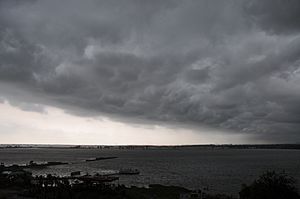
Around September, as the sun moves south, the northern parts of India start to cool down quickly. Air pressure builds up over northern India, while the Indian Ocean stays warm. This causes cold winds to blow from the Himalayas and Indo-Gangetic Plain towards the Indian Ocean. This is called the Northeast Monsoon or Retreating Monsoon.
As these dry, cold winds travel over the Bay of Bengal, they pick up some moisture. They then drop this moisture over southern India and parts of Sri Lanka. Cities like Chennai, which get less rain from the Southwest Monsoon, receive most of their rain from this monsoon. About 50% to 60% of the rain in Tamil Nadu comes from the Northeast Monsoon. In Southern Asia, this monsoon happens from October to December.
East Asian Monsoon
The East Asian monsoon affects large parts of Indo-China, the Philippines, China, Taiwan, Korea, and Japan. It has a warm, rainy summer monsoon and a cold, dry winter monsoon. The rain forms a belt that moves northward from May to July. This seasonal rain is known by different names: Meiyu in China, Jangma in Korea, and Bai-u in Japan.
Australian Monsoon
Also known as the Indo-Australian Monsoon, this monsoon brings the rainy season from September to February. It is a major source of energy for global weather patterns. The monsoon starts over the Maritime Continent (islands like Sumatra, Borneo, and the Philippines) and then moves to Northern Australia. Over three-quarters of the yearly rainfall in Northern Australia happens during this "Wet" season.
European Monsoon
The European Monsoon is more commonly known as the return of the westerlies. It's not a monsoon in the traditional sense, but it brings similar effects. It happens when strong westerly winds from the Atlantic Ocean pick up moisture and return to Europe. These winds are common in winter but calm down in spring. They pick up again in June, bringing rain.
The rain usually comes in two waves, in early June and again in mid-to-late June. These storms often bring colder temperatures, heavy rain or hail, thunder, and strong winds. The return of the westerlies affects Europe's Northern Atlantic coastline, including Ireland, Great Britain, the Benelux countries, Western Germany, Northern France, and parts of Scandinavia.
Images for kids
-
Monsoon clouds over Lucknow, Uttar Pradesh, India
-
Southeast African monsoon clouds, over Mayotte island
-
Monsoon clouds in Madhya Pradesh
See also
 In Spanish: Monzón para niños
In Spanish: Monzón para niños


